How do I prepare a new pan for use?
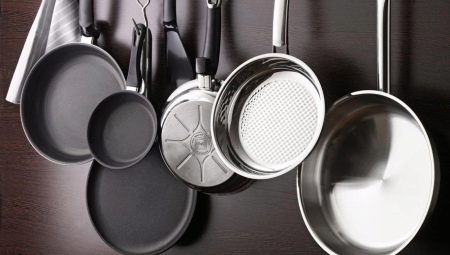
For many housewives, the purchase of a frying pan is a crucial step, because such kitchen utensils are often used, and they are not cheap. However, after the purchase, it is very important to properly prepare the pan for use, which will help to extend the life of the product and save you from some negative points.
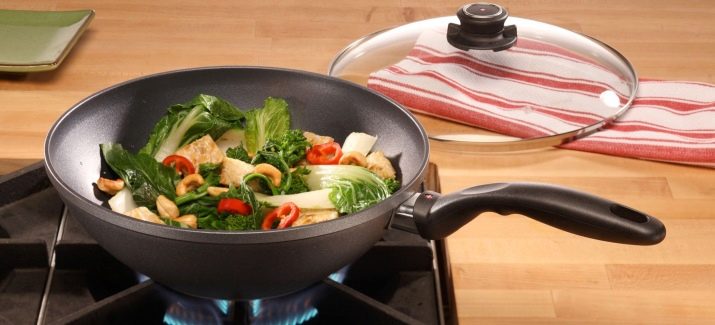
Why is preparation needed?
During the manufacture of a frying pan, the surface of the metal is covered with special protective agents. When heated, these compounds are capable of releasing volatile compounds. But the problem may not be just the smell. Improper preparation for the first use threatens with exacerbation of pathologies in households. For example, hypertensive patients may begin to suffer from headaches, and people prone to allergies may experience exacerbations. Therefore, this procedure should be considered as carefully as possible. Let's consider several types of pans in more detail.
Steel
Such a product is not afraid of corrosion. This statement is true when the correct ratio of chromium to nickel is selected. However, anyway the steel pan must be prepared for the first use, which is done by calcining and processing... First of all, the pan will need to be thoroughly rinsed and dried. A little crude oil is poured into its bottom so that the surface is completely hidden. Table salt is also poured there, and the product is put on a strong fire.
After heating, the heat is reduced and the pan remains in place for about 15 minutes. You need to turn off the stove when the first haze appears.When the procedure is completed, cool the product and carefully remove the remaining oil from it. It is not required to rinse and wipe it before the first cooking.

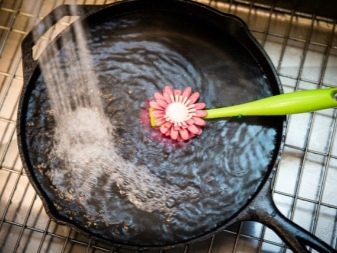
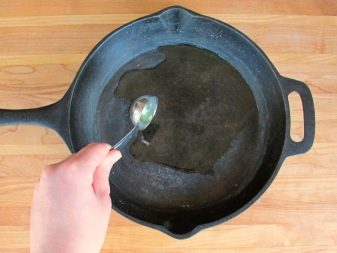
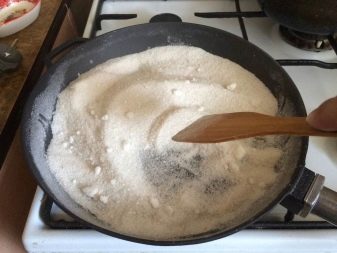
Aluminum
Preparing an aluminum product for work is also not too difficult. First of all, it is half filled with water, into which half a lemon is squeezed. The resulting liquid is placed on the stove and boiled for 20 minutes. With the help of hot steam, pathogenic bacteria and microorganisms are destroyed, while lemon juice allows you to get rid of foreign odors that are characteristic of any new product.
In this case, coarse salt can also be used for calcination. After the product is washed and dried, salt is poured onto the bottom of the product. It is required to heat the pan over low heat; the whole procedure will take about 20 minutes. At this time, an unpleasant smell can go, which is not at all scary. Then the stove is turned off. The salt should remain on the bottom until it has completely cooled down, after which it should be discarded. After that, the napkin is moistened in oil and the pan is gently wiped off.
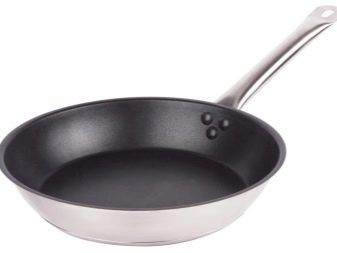
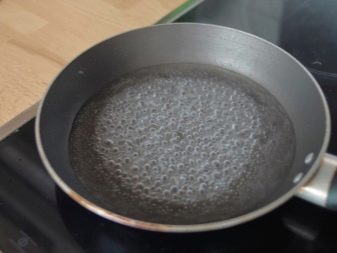
Non-stick coated
The difference between these products is that it is strictly forbidden to ignite them, otherwise the pan may not withstand and be damaged. However, certain preparatory manipulations are still present. The maintenance process for a non-stick frying pan is very simple. Before the first use, it should only be washed with a sponge, excluding abrasive detergents. When the surface is dry, it is wiped with a piece of soft cloth, which should first be slightly moistened with sunflower oil.
Important! Housewives should take into account that wiping with refined oil should be carried out periodically with dishes of this kind. This will help maintain the non-stick properties of the product. It will be enough to do this procedure once every 2-3 weeks.

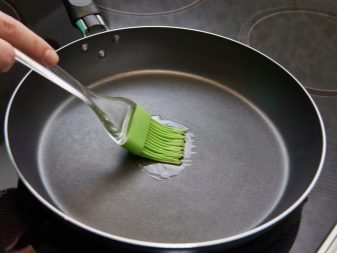
Why bake?
Preparation for operation is an important point. Calcination, in cases where it is necessary, can be carried out in any way. In addition to extending the service life, this procedure will help to identify defects in time. It is worth considering why else you need to carry out this manipulation.
Few are familiar with the process of making pans. The fact is that in the course of work, products are processed with ordinary machine oil. Accordingly, its benefits to the body are highly questionable. Most of the product is removed with a thorough dishwashing, but some remains. It is possible to get rid of it by heating the dishes.
In addition, calcination activates other positive aspects. After that, the frying pan acquires non-stick properties. She becomes not afraid of corrosion. Revealing a defect serves as a direct reason to return a low-quality product to the store on time or replace it with a new one. However, it must be borne in mind that annealing is unacceptable for ceramic and non-stick cookware. Such products initially have characteristics that can prevent food from burning. Aluminum, cast iron and steel pans should be ignited.
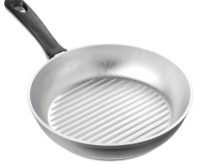
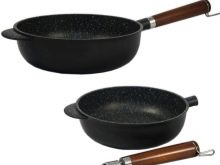
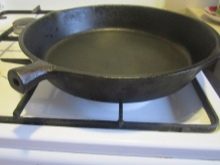
Calcination methods
Housewives used roasting even before the first non-stick pans appeared. This was the main way of preparing dishes for use, as it allowed them to clog the pores and create a protective surface. This condition helps to protect products from food burning. but first it is recommended to study the instructions. Calcination can be carried out in several ways.
With salt
This method is used by housewives most often. It's pretty straightforward. First of all, the purchased frying pan must be thoroughly washed and wiped, and then placed on low heat. Salt is poured onto the bottom, warmed up for about 20 minutes and left to cool completely.
After that, the salt is removed, and the product is wiped with a piece of soft cloth soaked in vegetable oil. It should be borne in mind that only the cooled surface should be processed. Wait a couple of days before using.
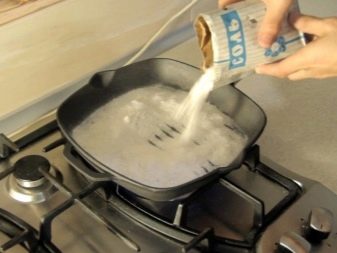
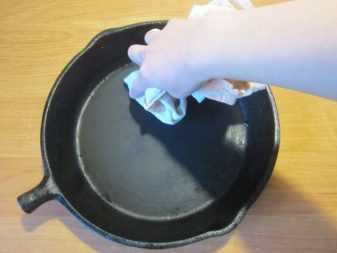
With salt-free water
Calcining the salt is very common, but not the only option. It is quite possible to do without it. All you need is water. It must be boiled in a new container for several minutes, drained and cooled. Next, the surface must be treated with oil. It is recommended to use the pan a few days after the procedure.

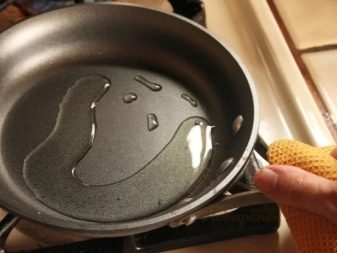
Vegetable oil
This method is also not difficult. Oil is poured into the prepared frying pan. It should be enough for the liquid to hide the bottom. The product is put on fire for 25 minutes, after which it cools down. The cold skillet should be rinsed and set aside for a couple of days. Keep in mind that this method is great for updating old products. It is recommended to use refined oil, it will give less smoke. And also it is worth opening the windows and turning on the hood, if there is one.
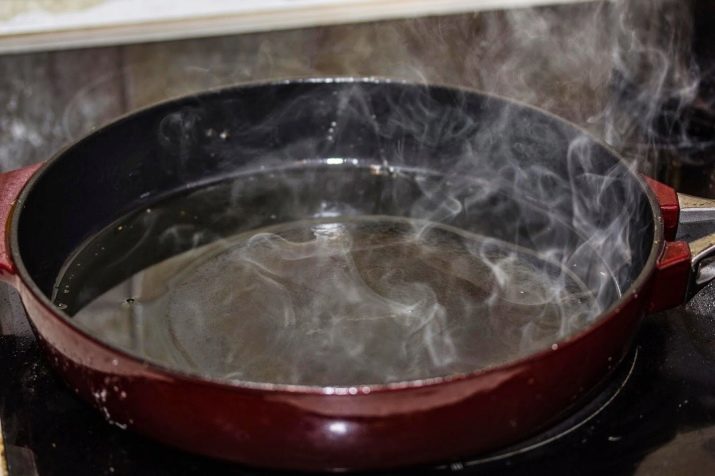
Calcining on the stove and in the oven
It is easiest to use a stove for this procedure. And also it is necessary to monitor the correctness and order of processing of products. Compliance with safety precautions will not be superfluous.
Another way is roasting in the oven. It will significantly save time, since you do not need to be at the stove during the procedure. To do this, the pan is greased on all sides with refined vegetable oil and placed in a hot oven for 1 hour so that the bottom is on top. After that, the fire turns off, and the product remains inside until it cools completely. After 2 hours, you need to check if the procedure was successful and repeat it if necessary. You can use the pan after 2 days.
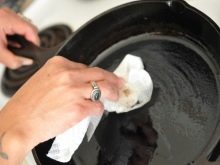
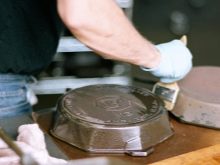
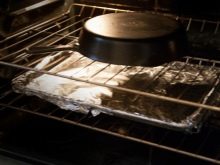
Safety regulations
Igniting a new frying pan is easy. However, in order to avoid trouble, you should follow safety precautions, namely:
- water must not be added to hot oil;
- a hot pan is also not allowed to be placed under cold water;
- thick clamps are useful in the procedure, they will help protect hands and surfaces;
- low-melting products located in the direct access zone should be removed.
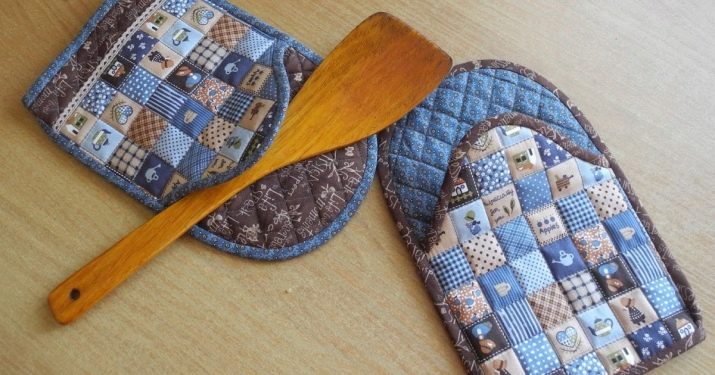
Is it dishwasher safe?
In this situation, it is necessary to study the instructions for use of the dishwasher. It specifies in detail what materials the products cannot be placed inside. The markings can also be on the dishes.
Teflon, aluminum and cast iron pans cannot be washed in the dishwasher, as this may damage them. In addition, the dishes can darken and release harmful substances. This is because the oxide film breaks down.
Strong water pressure and alkaline cleaners are not the best option. Reaction with water for a long time leads to the destruction of the metal. The process can take several years, but it's best not to risk it. Cookware that is properly prepared for the first use is very important. Only with proper processing will it serve the hostess for many years and not cause problems with cooking.
Next, watch a video on how to prepare a new frying pan for use.








